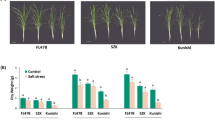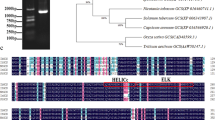Abstract
Constructing various green wetland examples for mangrove wetland systems is a useful way to use natural power to remediate the polluted wetlands at intertidal zones. Metallothioneins (MT) are involved in heavy metal tolerance, homeostasis, and detoxification of intracellular metal ions in plants. In order to understand the mechanism of heavy metal uptake in Aegiceras corniculatum, we isolated its metallothionein gene and studied the MT gene expression in response to heavy metals contamination. Here, we report the isolation and characterization of MT2 genes from young stem tissues of A. corniculatum growing in the cadmium (Cd) and lead (Pb) polluted wetlands of Quanzhou Bay, southeast of China. The obtained cDNA sequence of MT is 512 bp in length, and it has an open reading frame encoding 79 amino acid residues with a molecular weight of 7.92 kDa and the theoretical isoelectric point of 4.55. The amino acids include 14 cysteine residues and 14 glycine residues. It is a non-transmembrane hydrophilic protein. Sequence and homology analysis showed the MT protein sequence shared more than 60 % homology with other plant type 2 MT-like protein genes. The results suggested that the expression level of MT gene of A. corniculatum young stems induced by a certain range concentration of Cd2+ and Pb2+ stresses (0.2 mmol L−1 Pb2+, 1 mmol L−1 Pb2+, 0.2 mmol L−1 Pb2+, and 40 μmmol L−1 Cd2+; 1 mmol L−1 Pb2+ and 40 μmol L−1 Cd2+) compared with control might show an adaptive protection. The expression levels of MT gene at 20 h stress treatment were higher than those at 480 h stress treatment. The expression levels of MT gene with 0.2 mmol L−1 Pb2+ stress treatment were higher than those with 0.2 mmol L−1 Pb2+ and 40 μmol L−1 Cd2+ stress treatment, and the MT gene expression levels with 1 mmol L−1 Pb2+ treatment were higher than those with 1 mmol L−1 Pb2+ and 40 μmol L−1 Cd2+ treatment. There exists an antagonistic action between Pb2+ and Cd2+ in the MT metabolization of A. corniculatum.




Similar content being viewed by others
References
Babula, P., Masarik, M., Adam, V., Eckschlager, T., Stiborova, M., Trnkova, L., Skutkova, H., Provaznik, I., Hubalekadi, J., & Kizek, R. (2012). Mammalian metallothioneins: properties and functions. Metallomics, 4, 739–750.
Boulanger, Y., Goodman, C. M., Forte, C. P., Fesik, S. W., & Amitage, I. M. (1983). Model of mammalian metallothionein structure. Proceedings of the National Academy of Sciences of the United States of America, 80, 1501–1505.
Chen, G. Z., Ma, H., Wong, Y. S., & Tam, N. F. Y. (1998). The effects of treating synthetic municipal wastewater on Aegiceras corniculatum under simulated tidal condition. Acta Scientiarum Naturalium Universitatis Sunyatseni, 37(S2), 186–190.
De Miranda, J. R., Thomas, M. A., Thurman, D. A., & Tomsett, A. B. (1990). Metallothionein genes from the flowering plant Mimulus guttatus. FEBS Letters, 260, 277–280.
Deng, S. L., Su, G. H., Zeng, Q. L., & Shi, S. H. (2004). Isolating high-quality RNA from mangroves without liquid nitrogen. Plant Molecular Biology Reporter, 22, 197a–197e.
Duncan, K. E. R., & Stillman, M. J. (2006). Metal-dependent protein folding: metalation of metallothionein. Journal of Inorganic Biochemistry, 100, 2101–2107.
Guirola, M., Pérez-Rafael, S., Capdevila, M., Palacios, O., & Atrian, S. (2012). Metal dealing at the origin of the Chordata phylum: the metallothionein system and metal overload response in amphioxus. Coordination Chemistry Reviews, 256, 46–62.
Huang, G. Y., & Wang, Y. S. (2010). Expression and characterization analysis of type2metallothionein from gray mangrove species (Avicennia marina) in response to metal stress. Aquatic Toxicology, 99(1), 86–92.
Huang, G. Y., Wang, Y. S., & Ying, G. G. (2011). Cadmium-inducible BgMT2, a type 2 metallothionein gene from mangrove species (Bruguiera gymnorrhiza), its encoding protein shows metal-binding ability. Journal of Experimental Marine Biology and Ecology, 405, 128–132.
Kamala-Kannan, S., Prabhu Dass Batvari, B., Kui Jae Lee, N., Kannanb, Krishnamoorthy, R., Shanthi, K., & Jayaprakash, M. (2008). Assessment of heavy metals (Cd, Cr, and Pb) in water, sediment, and seaweed (Ulva lactuca) in the Pulicat Lake, Southeast India. Chemosphere, 71(7), 1233–1240.
Kayaalti, Z., Aliyev, V., & Soylemezogiu, T. (2011). The potential effect of metallothionein 2A-5 A/G single nucleotide polymorphism on blood cadmium, lead, zinc, and copper levels. Toxicology and Applied Pharmacology, 256(1), 1–7.
Kim, Y. O., Patel, D. H., Lee, D. S., Song, Y., & Bae, H. J. (2011). High cadmium-binding ability of a novel Colocasia esculenta metallothionein increases cadmium tolerance in Escherichia coli and tobacco. Bioscience, Biotechnology, and Biochemistry, 75(10), 1912–1920.
Li, Y. H., Yan, C. L., Yuan, J. J., Liu, J. C., Chen, H. Y., & Hu, J. (2006). Partitioning of heavy metals in the surface sediments of Quanzhou Bay wetland and its availability to Suaeda australis. Journal of Environmental Science, 18(2), 334–340.
Li, Y. H., Hu, H. Y., Liu, J. C., & Wu, G. L. (2010). Distribution and mobility of copper, zinc and lead in plant-sediment systems of Quanzhou Bay Estuary, China. International Journal of Phytoremediation, 12(3), 291–305.
Nordberg, M., & Nordberg, G. F. (2000). Toxicological aspects of metallothionein. Cellular and Molecular Biology (Noisy-le-grand), 46, 451–463.
Palmiter, R. D. (1998). The elusive function of metallothioneins. Proceedings of the National Academy of Sciences of the United States of America, 95, 8428–8430.
Robertson, A. I., & Phillips, M. J. (1995). Mangroves as filter of shrimp pond effluent: prediction and biogeochemical research needs. Hydrobiologia, 295, 311–321.
Tam, N. F. Y., & Wong, Y. S. (1994). Nutrient and heavy metals and plant mineral nutrients. Acta Societatis Botanicorum Poloniae, 64(3), 265–271.
Tam, N. F. Y., & Wong, Y. S. (1996). Retention and distribution of heavy metals in mangroves soils receiving wastewater. Environment Pollution, 94, 283–291.
Tang, T., Huang, D. W., Zhang, D., Wu, Y. J., Murphy, R. W., & Liu, F. S. (2011). Identification of two metallothionein genes and their roles in stress responses of Musca domestica toward hyperthermy and cadmium tolerance. Comparative Biochemistry and Physiology. Part B, Biochemistry & Molecular Biology, 160(2–3), 81–88.
Trinchella, F., Esposito, M. G., & Scudiero, R. (2012). Metallothionein primary structure in amphibians: insights from comparative evolutionary analysis in vertebrates. Comptes Rendus Biologies, 335(2012), 480–487.
Ungherese, G., Baroni, D., Bruni, P., Focardi, S. E., & Ugolini, A. (2011). Metallothionein induction in the sandhopper Talitrus saltator (Montagu) (Crustacea, Amphipoda). Water, Air, and Soil Pollution, 219, 343–351.
Valls, M., & Lorenzo, V. D. (2002). Exploiting the genetic and biochemical capacities of bacteria for the remediation of heavy metal pollution. FEMS Microbiology Reviews, 26, 327–338.
Vasák, M., & Hasler, D. W. (2000). Metallothioneins: new functional and structural insights. Current Opinion in Chemical Biology, 4(2), 177–183.
Zhang, Y. W., Tam, N. F. Y., & Wong, Y. S. (2004). Cloning and characterization of type 2 metallothionein-like gene from a wetland plant Typha latifolia. Plant Science, 167, 869–877.
Zhang, F. Q., Wang, Y. S., Lou, Z. P., & Dong, J. D. (2007). Effect of heavy metal stress on antioxidative enzymes and lipid peroxidation in leaves and roots of two mangrove plant seedlings (Kandelia candel and Bruguiera gymnorrhiza). Chemosphere, 67, 44–50.
Zhang, F. Q., Wang, C. C., Luo, Z. P., & Dong, J. D. (2012). A novel metallothionein gene from a mangrove plant Kandelia candel. Ecotoxicology, 21, 1633–1641.
Acknowledgment
This work was supported by the Key Project of Universities Serving to the Construction of Western Taiwan Straits of Fujian province of China (no. A101) and the Fundamental Research Funds for the Central Universities (no. 2010121093).
Author information
Authors and Affiliations
Corresponding author
Rights and permissions
About this article
Cite this article
Yuhong, L., Atagana, H.I., Jingchun, L. et al. cDNA sequence encoding metallothionein protein from Aegiceras corniculatum and its gene expression induced by Pb2+ and Cd2+ stresses. Environ Monit Assess 185, 10201–10208 (2013). https://doi.org/10.1007/s10661-013-3324-y
Received:
Accepted:
Published:
Issue Date:
DOI: https://doi.org/10.1007/s10661-013-3324-y




